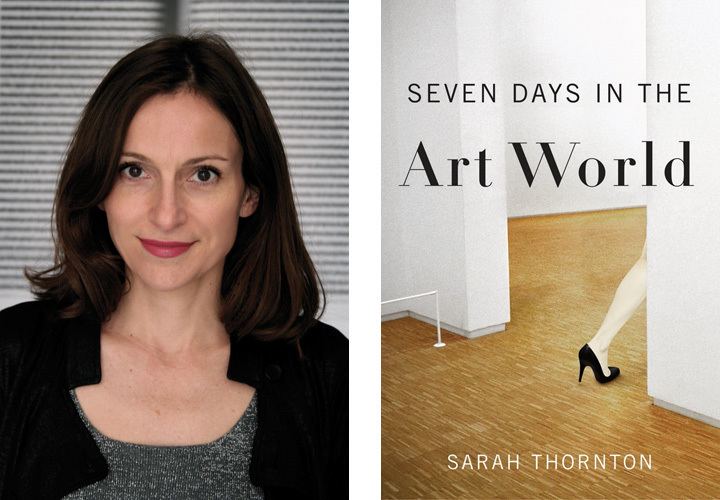Name Sarah Thornton Role Writer | Main interests Author | |
Books Seven days in the art world, Club cultures | ||
Alma mater University of Strathclyde | ||
Sarah thornton 33 artists in 3 acts
Sarah L. Thornton is a writer, ethnographer and sociologist of culture. Thornton has authored three books and many articles about art, artists, the art market, the history of music technology, dance clubs, raves, cultural hierarchies, subcultures and ethnographic research methods.
Contents
- Sarah thornton 33 artists in 3 acts
- Sarah thornton are artists the 21st century entrepreneurs
- Life and work
- 33 Artists in 3 Acts
- Seven Days in the Art World
- Club Cultures Music Media and Subcultural Capital
- Journalism
- Legal Action
- References

Sarah thornton are artists the 21st century entrepreneurs
Life and work

Thornton was born in Canada, lived in London, England, for over 20 years and now resides in San Francisco, CA. Her education comprises a BA in the History of Art from Concordia University, Montreal, and a PhD in the Sociology of Culture from Strathclyde University, Glasgow. Her academic posts have included a full-time lecturership at the University of Sussex, and a period as Visiting Research Fellow at Goldsmiths, University of London. Thornton worked for one year as a brand planner in a London advertising agency. She was the chief writer about contemporary art for The Economist. Thornton has written for publications including The Sunday Times Magazine, The Art Newspaper, Artforum.com, The New Yorker, The Telegraph, The Guardian, and The New Statesman.
33 Artists in 3 Acts

Thornton's most recently published book, 33 Artists in 3 Acts, looks at the lives and work of figures "from all over the art ecosystem, from the market-driven mogul (Jeff Koons) to the profoundly intellectual performance artist (UCLA professor Andrea Fraser) to the impish prankster (Italian conceptual artist Maurizio Cattelan.)" The central question guiding the book is: What defines an artist in the 21st century? Thornton received "a range of answers that will startle even art-world insiders." Jackie Wullshlager of the Financial Times opined that Thornton is "skillfully nuanced" and "elevates gossip to sociology, writing with verve, insight and authenticity."

33 Artists in 3 Acts received praise for its academic approach and "attention to detail and illustration of subtleties that bring her interviewees to life.... [Thornton's] flair for creating clear structures offer readers manageable points of access... without ever compromising on quality or content, or sounding pretentious."
Seven Days in the Art World

The New York Times' Karen Rosenberg said that Seven Days in the Art World "was reported and written in a heated market, but it is poised to endure as a work of sociology...[Thornton] pushes her well-chosen subjects to explore the questions ‘What is an artist?’ and ‘What makes a work of art great?’"
In the UK, Ben Lewis wrote in The Sunday Times that Seven Days was "a Robert Altmanesque panorama of...the most important cultural phenomenon of the last ten years". While Peter Aspden argued in the Financial Times that "[Thornton] does well to resist the temptation to draw any glib, overarching conclusions. There is more than enough in her rigorous, precise reportage… for the reader to make his or her own connections."
András Szántó reviewed Seven Days in the Art World: "Underneath [the book's] glossy surface lurks a sociologist’s concern for institutional narratives as well as the ethnographer’s conviction that entire social structures can be apprehended in seemingly frivolous patterns of speech or dress."
Club Cultures: Music, Media, and Subcultural Capital
In Club Cultures, Thornton examines the shift from live to recorded music for public dancing (from record hops to raves) and the resistance to recording technology's enculturation of the "authentic," valued cultural form. The book also analyzes the dynamics of "hipness," critiquing Pierre Bourdieu's theory of cultural capital with her own formulation of "subcultural capital." The study responds to earlier works such as Dick Hebdige's Subculture: The Meaning of Style. It does not see media as a reflection of social groups, but as integral to their formation.
Local micro-media like flyers and listings are means by which club organizers bring the crowd together. Niche media like the music press construct subcultures as much as they document them. National mass media, such as tabloids, develop youth movements as much as they distort them. Contrary to youth subcultural ideologies, "subcultures" do not germinate from a seed and grow by force of their own energy into mysterious ‘movements’ only to be belatedly digested by the media. Rather, media and other culture industries are there and effective right from the start. They are central to the process of subcultural formation.
The book is described by Stuart Hall and Tony Jefferson as "theoretically innovative" and "conceptually adventurous".
Journalism
At The Economist, Thornton penned investigative and analytical articles about the inner workings of the contemporary art market. Her writing often explores issues such as the value of art, the role of museum validation and branding, and the impact of gender on auction prices. In 2010, she wrote an article about the Damien Hirst auction, "Beautiful Inside My Head Forever", which took place on the evening that Lehman Brothers went bankrupt in 2008. The article explained how the auction turned out so successful.
Recently Thornton's articles have begun to shift focus onto the tech world of Silicon Valley. In 2016 for Cultured Magazine she published a profile on Mike Krieger, co-founder and CTO of Instagram.
Legal Action
On 26 July 2011, Thornton won a historic libel and malicious falsehood victory against Lynn Barber and The Daily Telegraph. All three of the Telegraph′s attempts to appeal were denied.This link is dead.
